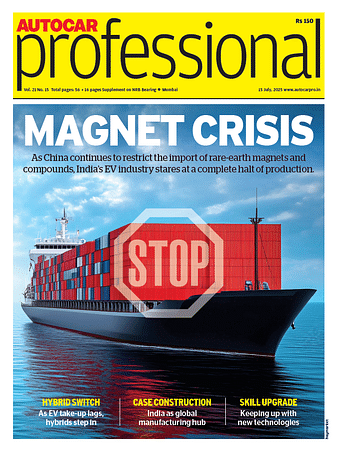Bajaj Auto Faces EV Production Halt in August Amid Rare Earth Shortage: Reports
Bajaj Auto warns of zero EV output in August amid rare earth magnet crunch. Supply chain disruption threatens festive season sales and India's clean mobility momentum.
Bajaj Auto is staring at an imminent production halt in August due to an acute shortage of heavy rare earth magnets, a critical component in electric vehicle (EV) motors, according to The Economic Times report.
Managing Director Rajiv Bajaj has warned of major disruptions not only to the company’s electric portfolio but also to the broader EV ecosystem unless urgent steps are taken by policymakers to provide clarity and intervention. “We are down by half in terms of production in the current month, and I am afraid that we are looking at a zero month in August as of now,” Bajaj said. “Should that happen, it would not just significantly impact our leading share and revenue, but also our EBITDA as our EV portfolio is now reasonably profitable.”
Bajaj Auto had recently taken pole position in India’s fast-growing EV segments—with the Chetak leading electric scooter sales and its GoGo dominating the electric three-wheeler space. However, the sudden curb on imports of heavy rare earth magnets, most of which are sourced from China, has severely disrupted the supply chain.
While smaller-volume manufacturers may still manage with limited inventory, Bajaj said the company’s higher volumes make it particularly vulnerable to the shortage, especially with the high-demand festive season approaching.
No Quick Fixes
In terms of contingency plans, Bajaj said that there are no viable short-term alternatives to rare earth magnets. Medium-term options like switching to alternative motor technologies or non-Chinese sources are being explored—but both involve significant challenges. “Changing product design and/or the supply chain is easier said than done,” he explained, “because it sets you back on what is already a steep learning curve in terms of quality and cost.”
This reliance on a single country for high-performance magnets is emerging as a strategic bottleneck for India’s EV sector, echoing a broader global concern about China’s dominance in rare earth supplies.
Seeking Policy Flexibility
On possible relaxations under key policy schemes like the Production Linked Incentive (PLI) program, Bajaj said with companies potentially forced to import sub-assemblies due to component shortages, there have been informal discussions around easing domestic value addition (DVA) norms—but no concrete resolutions yet.
“While Bajaj has not sought such a waiver, I am supportive of those who have, given that this is an acute situation brought on by unusual circumstances,” Bajaj said. “However, we have not heard anything conclusive in this regard.”
What Can the Centre Do?
While Bajaj refrained from prescribing how the Indian government should engage with China on rare earth imports, he urged for a more open and consistent communication channel with stakeholders. “Our government should as much as possible be giving all of the stakeholders greater clarity on what the exact situation is and what their best judgement is in terms of the near-term outlook,” he said.
He urged the government to offer timely updates and transparency to help manufacturers plan their operations more effectively. “Except for being given to understand that efforts are on, we know precious little,” he added.
Cost Pressures and Buyer Sensitivity
The shortage will likely increase production costs, although Bajaj said the exact impact remains uncertain. Any price hikes will depend on whether a suitable replacement material can be sourced quickly and affordably.
“The cost implication ranges from relatively small--if a suitable substitute becomes available from the current supply chain--to relatively large should this not materialise,” he said.
Passing these cost increases on to buyers may prove difficult in India’s price-sensitive two-wheeler market, particularly when EV penetration is still dependent on affordability and policy-driven incentives.
A Setback to EV Momentum
Beyond the impact on Bajaj Auto, Rajiv Bajaj voiced concern about the ripple effects the supply chain crunch will have on India’s broader EV ecosystem.
“In large metro markets, EV penetration is already about 25% in the scooter segment. These are markets where consumers now expect an EV product and may not easily switch back to ICE,” he said. “The demand contraction is real.”
But he worries more for ecosystem players--component suppliers and EV-focused dealers--who have made significant investments expecting policy continuity and market stability.
“These relatively small entrepreneurs and their employees will be hit very hard if the current status quo becomes chronic,” he said. “Finally, the momentum of the progress that the Indian industry was collectively making with EVs in line with the vision of the government will be seriously hampered.”
Maharashtra’s Delayed Incentive Payments
Compounding the issue is the long-pending reimbursement of EV subsidies by the Maharashtra government. Bajaj revealed that while the company has passed on state EV incentives to customers, it has received almost nothing back from the government in the last two years—except for a “tiny tranche” a few weeks ago.
“This delay has a significant impact on cash flow, and of course, the state never makes good the loss of interest,” he said. “More worrisome is what we hear informally—that the state finances may not permit it to fulfill its policy obligation.” He warned that such delays risk damaging Maharashtra’s image as a top investment destination, particularly in a sector as dynamic as electric mobility.
RELATED ARTICLES
Force Motors Retains Top CRISIL Credit Ratings Amid Robust Financial Health and Operational Gains
LCV maker’s AA+/Stable and A1+ ratings reaffirmed as it posts healthy revenue growth, improved margins, and turns debt-f...
Ola Electric's board approves change in IPO fund use, timeline extension
As of June 30, the company utilised only Rs 2,681 crore from the Rs 5,275 crore raised in its IPO last year. Rs 1,228 cr...
Nippon Paint Launches n-SHIELD PPF in India with India Champions Cricket Team
New product line aims to strengthen presence in automotive aftermarket with expanded network, new detailing solutions, a...





 By Autocar Professional Bureau
By Autocar Professional Bureau
 25 Jul 2025
25 Jul 2025
 866 Views
866 Views





 Sarthak Mahajan
Sarthak Mahajan


 Kiran Murali
Kiran Murali


